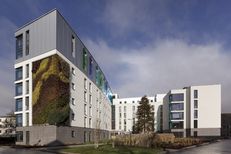Modelling sustainability through intelligent design at UEA
Crome Court is UEA’s newest and most energy-efficient accommodation block. The BREEAM Excellent project came in £800,000 under budget, and as one of the first projects in the UK to have achieved a fully-integrated Building Information Modelling (BIM) Level 2. It built on lessons from other elements of UEA’s low carbon campus and pioneered new intelligent modelling concepts.
The project won the Construction Computing Awards 2014 ‘Collaboration Project of the Year’ for computing excellence and collaboration within the built environment. The BIM process enabled both a speedy, 98-week delivery and the integration of sustainable principles from the very earliest stages.
The building superstructure of cross-laminated timber sequesters nearly 1400 tonnes of CO2. Grey water is recycled for toilets and to irrigate an external green wall. Renewables provide 69% of the calculated energy use, and an integrated energy data reporting system in every flat aims to encourage positive behaviours from residents.
Top 3 learnings
1 Use BIM as a tool to show value for money. BIM helped ensure impressive levels of space efficiency: while the national Gross Internal Area average is around 30m2 per bedroom, Crome Court delivered around 25m2 per bedroom. The Blackdale Development, our next accommodation addition currently under construction, used Crome Court as a blueprint and through BIM has surpassed these levels of high efficiency with a designed efficiency ratio of 23m2 per bedroom.
2 Take advantage of BIM as an aide to collaboration. As an intelligent system, BIM helped to get all internal stakeholders on board and provided certainty in the process. As clients, we were able to identify clashes ahead of the build and have more confidence that the finished produce would meet objectives. Crome Court has given the University management confidence in BIM as a cost-effective tool to enable financial efficiency, at the same time as bringing additional environmental improvements and opportunities to challenge preconceptions of standard and innovative building practices.
3 Promote the wider environmental agenda through case study examples. The use of cross-laminated timber meant a considerably lighter frame, reducing the required size of the foundations and therefore the related impact of concrete and other carbon-intensive materials. We used this to discuss embedded carbon with our project managers. CLT is also more efficient waste-wise than steel or concrete; we found a strong case study in promoting the zero waste produced on site, and how factory offcuts were used to create other products such as biomass pellets. The pre-fabricated walls reduced the noise and disturbance to other campus users; Crome Court was built in the centre of a built-up area while surrounding residences within 10m of the build site were still being inhabited, and only one noise complaint was received during the whole project!
Videos









 Except where otherwise stated, content on this site is
licensed under a Creative Commons Attribution 3.0 License.
Except where otherwise stated, content on this site is
licensed under a Creative Commons Attribution 3.0 License.
